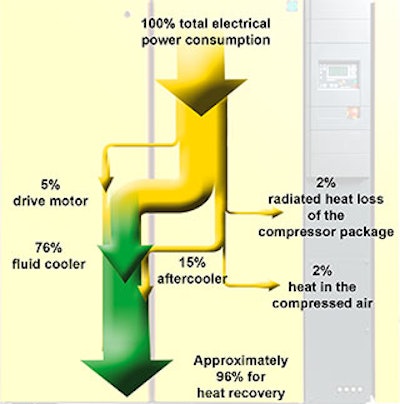
Industrial compressor systems are an investment. But the initial purchase price is just the beginning; even costlier than the equipment cost are the costs to run an air compressor and maintenance. With the recent, and steady, increases in energy costs, everyone is concerned with efficiency, and Kaeser Compressors, Inc.'s Waheed Chaudhry, engeering manager, recently sat down with IMPO to discuss just that.
Q: “A penny saved is a penny earned.” How does Benjamin Franklin’s quote apply to compressed air systems?
A: Energy costs are a significant portion of any compressed air system's total lifetime cost. In fact, the amount of energy required to run an air compressor for just one year can exceed the compressor purchase price. Over a period of 10 years, energy normally totals 70 percent of the overall costs. That’s why it is important to consider more than just the initial purchase price when determining which compressed air system to purchase. The money you can save every day on energy through, for example, proper controls schemes, leak reduction, and heat recovery, is money you can take to the bank day after day and year after year.
Q: When it comes to compressed air, what are the major issues you’re seeing in the industry today?
A: Given the steady increase in energy costs, everyone is concerned with efficiency. While this is understandable, it has created tunnel vision in many cases. By only looking at individual component efficiency, you miss the big picture of the compressed air system efficiency.
You can have the newest, most efficient equipment available on the market, but if it is not properly applied and controlled, you will not obtain the energy savings promised by the manufacturer. For example, a frequency drive compressor and a large air receiver is not always the best solution. These compressors are not meant for high load conditions. Also, many people forget to factor in drive losses to their variable speed compressor efficiency equation.
Another issue we are seeing is inaction. It is really striking to me that companies will devote time and money to conducting energy audits and leak detection, but they will fail to act on the recommendations. This is especially true with leaks. The Department of Energy estimates that the average leak rate for plants using compressed air is 25 percent. Some lose as much as 80 percent of their compressed air to leaks.
Companies will spend the time to have leaks identified in their compressed air system and even after seeing the numbers of how much money they are losing each year in energy costs to the leaks, they remain complacent. They may use Band-Aid measures on some larger leaks, but they are reluctant to put lasting solutions into effect.
Q: How can today’s major issues best be addressed?
A: The best way to ensure energy optimization is to take a holistic approach to the compressed air system. The focus should not be on individual components, but rather on the efficiency of the entire system. By choosing equipment that is best suited to the application and using a master controller that can ensure the equipment continually operates at its optimal design point, you can obtain sustainable energy savings. When the master controller has built-in communications capabilities, you also have access to real time data.
Also of importance is keeping the big picture in mind. It may take more time to fully fix leaks in your compressed air piping, but the payback on fixing those leaks is immediate. Instead of only focusing on the related costs of the downtime caused by fixing the leaks, it is more important to consider the money in energy costs you are bleeding out the leaks.
Q: In a dynamic manufacturing environment, what are the advantages and disadvantages of modular compressed air piping systems?
A: For the disadvantages, no one likes to replace piping because it always means production downtime. This is where the advantages of modular aluminum piping for compressed air come in to play. This type of piping system is lightweight and the installation time is greatly reduced in comparison to traditional piping materials. It is also easy to modify for future growth and can easily be engineered and integrated into existing systems. Additionally, if down the road your plant changes locations, you can easily take the modular style piping with you to the new location. It is easy to modify and convenient in terms of assembly.
Probably the best advantage is that the aluminum material will not rust or corrode, which gives you sustained compressed air quality. It has no rough surfaces or interior restrictions that accumulate contaminants. You do not have to worry about artificial pressure loss that is typical with other types of pipe, like black iron.
Q: How can industrial compressed air users realize heat recovery savings to be even more energy efficient?
A: Energy cost reduction strategies are vital to staying competitive. One major source for optimization often overlooked is recovering the heat generated by compressors. Since 100 percent of the electrical energy used by an industrial air compressor is converted into heat and 96 percent of this energy is available for recovery, the potential for savings is huge.
This can be as simple as ducting away the warmed compressed cooling air to provide space heating for warehouses, workshops, or other areas where heating is needed. By installing thermostatically controlled, motorized louvers for venting, you can ensure a consistent room temperature is maintained.
Rejected heat can also be used to heat water or other fluids. Typically the best efficiencies for these applications are achieved by water-cooled compressors. The discharged cooling water is connected directly to a continuous process heating application for year-round energy savings.
The key to unlocking these savings is to have a properly designed system with heat recovery integrated.



















